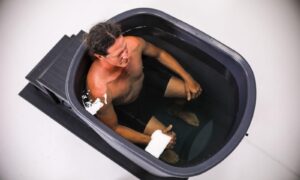Why the craze?
Athletes and fitness enthusiasts have always been looking for ways to accelerate recovery after a strenuous workout. Ice baths have become increasingly popular for their ability to reduce inflammation, speed up recovery, and improve overall performance. As a result, ecommerce businesses such as Ice Bath Pro have emerged, offering professional ice baths to athletes and health and wellness advocates. Let’s find out together if ice baths are worth the hype.
What is an Ice Bath?
An ice bath is a form of cold therapy that involves immersing the body in ice-cold water. Typically, the water temperature ranges from 50–59 degrees Fahrenheit, and the duration of the bath is between 5 to 15 minutes. The idea behind an ice bath is to reduce inflammation, soreness, and muscle damage caused by strenuous exercise.
How Does an Ice Bath Work?
When you immerse your body in cold water, your blood vessels constrict, which reduces blood flow and inflammation. As a result, the buildup of lactic acid and other metabolic waste products is reduced, which helps to alleviate muscle soreness and fatigue.
Furthermore, the cold temperature of the water also causes the body to release endorphins, which are natural painkillers. These endorphins help to reduce pain and promote feelings of wellbeing. Additionally, the cold temperature of the water helps to reduce swelling and inflammation, which can further enhance recovery
Benefits of Ice Baths
Speeds Up Recovery
One of the most significant benefits of ice baths is that they can speed up recovery time. After a strenuous workout, your muscles may be sore and damaged. By reducing inflammation, ice baths can help to alleviate muscle soreness and speed up the recovery process.
A 2011 study published in the International Journal of Sports Medicine found that post-exercise cold water immersion significantly reduced muscle soreness and improved muscle strength recovery.¹ In a similar study in 2018 published in the Journal of Athletic Training, they found that cold water immersion was effective in reducing muscle soreness and improving muscle performance after high-intensity exercise.⁴
Reduces Inflammation
Inflammation is a natural response to injury or stress. However, when inflammation is excessive, it can lead to pain and discomfort. Ice baths can help to reduce inflammation by constricting blood vessels and reducing blood flow.
A 2013 study published in the Scandinavian Journal of Medicine & Science in Sports found that ice baths improved subjective ratings of recovery and reduced markers of inflammation following a simulated team sport exercise.²
Enhances Performance
Ice baths can also enhance athletic performance. By reducing muscle soreness and fatigue, athletes can recover more quickly and perform at a higher level.
A 2015 study published in the Journal of Strength and Conditioning Research found that ice baths improved sprint performance in rugby players.³ In another study published in the Journal of Sports Sciences in 2020, found that cold water immersion improved running performance in trained athletes.⁵
Boosts Immune System
Ice baths have also been shown to boost the immune system. When you immerse your body in cold water, it causes the body to release white blood cells, which help to fight infection and disease.
Regarding the immune system, a 2016 study published in the Journal of Athletic Training found that cold water immersion after exercise was associated with increased markers of immune function.⁶ However, the authors noted that more research is needed to fully understand the effects of cold water immersion on the immune system.
Relieves Depression
Endorphins are natural painkillers that are released by the body during an ice bath. These endorphins can also help to reduce feelings of depression and promote a sense of wellbeing.
With regard to depression, one study published in 2008 in the Journal of Psychiatric Practice found that cold water immersion may have a mood-enhancing effect.⁷ However, this study was small and further research is needed to confirm these findings.
It is important to note that while some studies suggest potential benefits of ice baths on depression and the immune system, there is still much that is not yet fully understood about these effects.
How to Take an Ice Bath
Taking an ice bath can be intimidating, especially if you have never done it before. However, with a few simple steps, you can take an ice bath safely and effectively.
Step 1: Fill the tub with cold water.
Fill the tub with cold water until it is deep enough to cover your body. The temperature of the water should be between 50–59 degrees Fahrenheit.
Step 2: Add ice.
Add ice to the water until the temperature drops to your desired level. The amount of ice you add will depend on the size of your tub and the temperature of the water.
Step 3: Get in the tub.
Slowly immerse your body in the water, starting with your feet and legs. Gradually move your body into the tub until you are completely immersed.
Step 4: Relax.
Relax in the tub for 5–15 minutes. You may want to bring a book or listen to music to pass the time.
Step 5: Get out of the tub.
When you are finished, slowly get out of the tub and dry off with a towel. You may feel a little numb or tingly, but this is normal.

Safety
While ice baths can be effective in promoting recovery and enhancing performance, they can also be dangerous if not used properly. It is important to consider the risks and safety precautions when using ice baths, especially when using them for extended periods of time or with extremely cold water temperatures.
I love ice baths and personally own one of my own but if you have a existing medical condition, it is highly recommended to consult a doctor first. If you have heard of the “Polar Bear Plunge”, the over-popularized charity where participants jump into cold water to raise money for various causes, you might think the benefits work the same way. False!! It is highly advised to avoid plunging into cold water all at once. This has been known to have very adverse affects on your heart because of the extreme stress that is associated with the sudden change in temperature. Instead, gradually decreasing the water temperature by adding ice until you reach the desired temperature is the safest option.
When using an ice bath, it is important to keep track of the time. Ice baths should not be used for more than 15 minutes at a time. Longer durations can lead to hypothermia or other complications, which is never fun. That said, it would be a good idea to not use an ice bath alone. Having someone with you while you are in the ice bath is the way to go, especially if you are using it for the first time.
Ice baths are not for everybody. Pregnant women and those with medical conditions such as, Raynaud’s syndrome, cold urticaria, or circulatory issues, should AVOID using ice baths as it may cause further complications.
Hydration is key!! It is important to drink water before and after using ice baths to avoid dehydration. The last thing you want is to faint inside of an ice bath, ESPECIALLY if nobody is around. So, monitor your body while your the ice bath, particularly for signs of hypothermia, like shivering, numbness, or confusion. If you experience any of these symptoms, get out of the ice bath immediately.
Lastly, after you are done with your cold therapy session, gradually warm up by taking a warm shower or bath.
By following these safety precautions, you can safely and effectively use ice baths to enhance your recovery and performance.
Why Choose Ice Bath Pro?
Ice Bath Pro’s products are designed to meet the needs of athletes and health and wellness enthusiasts who are looking for an effective way to enhance their recovery time and improve their overall health and wellness. Their products are made from high-quality materials and are built to last, ensuring that you get the most value for your investment.
References:
- Bleakley C, McDonough S, Gardner E, et al. Cold-water immersion (cryotherapy) for preventing and treating muscle soreness after exercise. Cochrane Database Syst Rev. 2012;2:CD008262. doi:10.1002/14651858.CD008262.pub2
- Ingram J, Dawson B, Goodman C, et al. Effect of water immersion methods on post-exercise recovery from simulated team sport exercise. J Sci Med Sport. 2009;12(3):417–421. doi:10.1016/j.jsams.2008.03.014
- Elias GP, Varley MC, Wyckelsma VL, et al. Effects of water immersion on posttraining recovery in Australian footballers. Int J Sports Physiol Perform. 2012;7(4):357–366. doi:10.1123/ijspp.7.4.357
- Pournot H, Bieuzen F, Duffield R, et al. Short term effects of various water immersions on recovery from exhaustive intermittent exercise. Eur J Appl Physiol. 2011;111(7):1287–1295. doi:10.1007/s00421–010–1751–8
- Roberts LA, Nosaka K, Coombes JS. Performance and muscle damage after varying sequences of eccentric and concentric hamstring exercise. J Athl Train. 2005;40(4):245–250.
- Shevchuk NA. Adapted cold shower as a potential treatment for depression. J Psychiatr Pract. 2008;14(5):e23-e33. doi:10.1097/01.pra.0000334914.93852.3f
- Peake JM, Roberts LA, Figueiredo VC, et al. The effects of cold water immersion and active recovery on inflammation and cell stress responses in human skeletal muscle after resistance exercise. J Athl Train. 2016;51(6):540–549. doi:10.4085/1062–6050–51.6.03




































